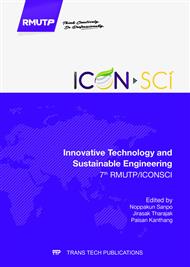p.301
p.305
p.309
p.313
p.318
p.322
p.329
p.333
p.337
Effect of Deposition Time on Structure of TiAlN Thin Films Deposited by Reactive DC Magnetron Co-Sputtering
Abstract:
Titanium aluminum nitride (TiAlN) thin films were deposited by reactive DC magnetron co-sputtering technique on Si substrate. The effect of deposition time on the structure of the TiAlN films was investigated. The crystal structure, surface morphology, thickness and elemental composition were characterized by X-ray diffraction (XRD), field emission scanning electron microscopy (FE-SEM) and energy dispersive X-ray spectroscopy (EDS) technique, respectively. The results showed that, all the as-deposited films were formed as a (Ti,Al)N solid solution. The as-deposited thin films exhibited a nanostructure with a crystallite size of less than 30 nm. The film thickness increase from 115 nm to 329 nm, while the lattice parameter decrease from 4.206 Å to 4.196 Å, with increasing of the deposition time. Cross section analysis by FE-SEM showed compact columnar and dense morphology as a result of increasing the deposition time. The elemental composition of the as-deposited films varied with the deposition time.
Info:
Periodical:
Pages:
318-321
Citation:
Online since:
June 2017
Authors:
Price:
Сopyright:
© 2017 Trans Tech Publications Ltd. All Rights Reserved
Share:
Citation:


